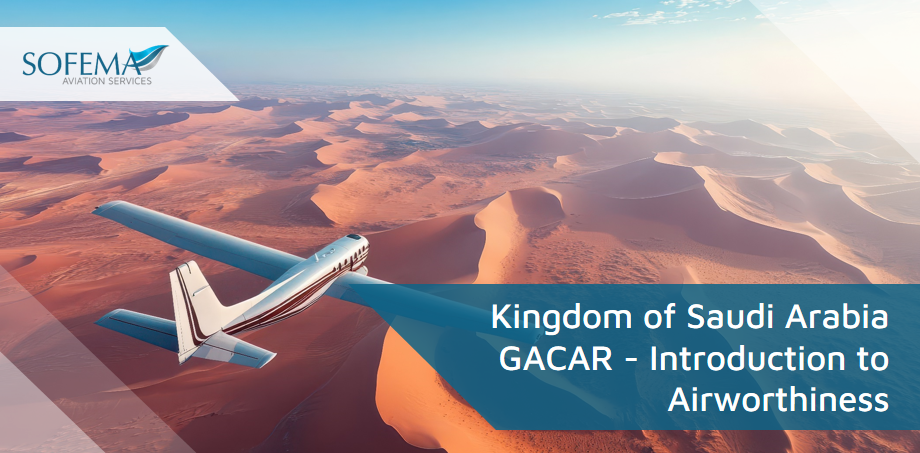Sofema Aviation Services (SAS) www.sassofia.com – Considers key aspects of the role of Airworthiness within the Kingdom of Saudi Arabia – General Authority of Civil Aviation of Saudi Arabia (GACAR) aviation system and how this is achieved
Airworthiness is a comprehensive, ongoing process that integrates design, production, maintenance, and operational compliance to ensure the safety and functionality of aircraft and their components. Regulatory oversight and continuous inspections ensure that aircraft remain safe throughout their operational life. Maintaining airworthiness requires strict adherence to regulatory standards, constant vigilance, and proactive risk management to protect passengers, crew, and the public from potential hazards.
Introduction
- Airworthiness is a fundamental concept in aviation, ensuring that an aircraft or its components are fit for safe operation.
- It encapsulates compliance with specific regulatory standards and involves a continuous process of design, manufacturing, maintenance, and operational oversight.
- National and international regulatory authorities such as the International Civil Aviation Organization (ICAO), the European Union Aviation Safety Agency (EASA), the Federal Aviation Administration (FAA), and the General Civil Aviation Authority (GCAA) govern airworthiness standards globally.
Key Elements of Airworthiness
- Design and Type Certification Airworthiness begins with the design and certification process, ensuring that the aircraft or component design complies with applicable safety standards, such as ICAO standards or EASA’s Certification Specifications (CS).
- Upon meeting these standards, a Type Certificate (TC) is issued, certifying the design as airworthy for production and operation under strict quality control.
- Production Quality Control The approved design must be adhered to during the manufacturing process. Regulatory authorities monitor manufacturing through Production Organization Approvals (POA) to ensure that each part or aircraft is produced according to the certified design and safety standards.
- Maintenance and Continuing Airworthiness Continuing airworthiness is crucial for the ongoing safety of the aircraft.
- This includes regular inspections, modifications, and compliance with Airworthiness Directives (ADs) issued to address specific safety concerns.
- Maintenance organizations, certified under frameworks like EASA Part 145 or GACAR Parts 145 & 43, follow rigorous documentation and inspection procedures to ensure continued airworthiness.
- Airworthiness Directives (ADs) When a safety issue arises with a particular aircraft model or component, authorities issue ADs that mandate inspections, repairs, or grounding until compliance is achieved.
- ADs are crucial for addressing risks that may emerge after initial certification, helping maintain operational safety.
- Certification of Components (Parts and Materials) Components, including engines, avionics, and structural parts, must also meet airworthiness standards.
- These components are classified based on their criticality and undergo rigorous testing and certification processes to ensure they meet safety and performance requirements.
- Human Factors and Procedures Proper application of procedures, adherence to manufacturer guidelines, and continuous training for maintenance personnel are vital to maintaining airworthiness.
- A robust Safety Management System (SMS) helps mitigate human error and procedural lapses that could compromise safety.
- Registration and Operational Certification: Once the aircraft is built and meets airworthiness standards, it must be registered with the appropriate aviation authority. This is followed by the issuance of an Airworthiness Certificate (C of A), confirming that the aircraft is fit for operation. Without this certificate, an aircraft is not legally permitted to fly.
- Modifications and Repairs – Modifications to an aircraft must be carefully regulated to ensure they do not compromise airworthiness. Supplemental Type Certificates (STCs) are required for significant changes to the design, while repairs must meet strict approval standards to restore airworthiness to its original certified level.
- Airworthiness in the Saudi Arabian Context: GACAR Regulations –The General Authority of Civil Aviation (GACA) in Saudi Arabia plays a pivotal role in enforcing airworthiness standards within the Kingdom, primarily through GACAR Part 21, which governs certification procedures for aircraft and components. Key regulatory aspects include:
- Type Certification – GACAR Part 21, Subpart B, GACA certifies aircraft designs based on international standards. Aircraft entering service in Saudi Arabia must comply with these types of certification standards, often based on certifications from recognized foreign aviation authorities.
- Airworthiness Certificates – GACAR Part 21, Subpart F; these certificates confirm that the aircraft meets the necessary safety standards and is fit for flight. Special categories, such as light-sport or experimental aircraft, may require specific certification.
- Supplemental Type Certificates (STC): Required when an aircraft undergoes significant modifications, ensuring that the alterations comply with safety standards.
- Continued Airworthiness: Continuous compliance with maintenance standards, failure reporting, and defect management as stipulated in GACAR Part 21 ensures ongoing operational safety.
- Role of Regulatory Authorities – Regulatory bodies such as GACA, FAA, EASA, and GCAA work to maintain airworthiness by certifying designs, overseeing manufacturing processes, enforcing maintenance standards, and issuing ADs as needed. These agencies collaborate globally to harmonize airworthiness standards, ensuring a high level of safety across all stages of an aircraft’s life cycle.
- Importance of Compliance and Safety – Compliance with airworthiness regulations is mandatory for maintaining safety in aviation.
>> Non-compliance can lead to penalties, revocation of certification, or even grounding of aircraft.
>> Ensuring ongoing airworthiness through inspections, repairs, and modifications is essential for the safety of both aircraft operators and passengers.
Next Steps
Follow this link to our Library to find & download related documents for Free.
Sofema Aviation Services provides regulatory training that is compliant with GACAR Parts Parts 43 and 145. Please see the following link or email team@sassofia.com.
Tags:
Compliance, Human Factors, Safety, Airworthiness, Repairs, Kingdom of Saudi Arabia, SAS blogs, Aviation System, Airworthiness Directives (ADs), GACAR, General Authority of Civil Aviation, Production Quality Control, GACAR Part 21





